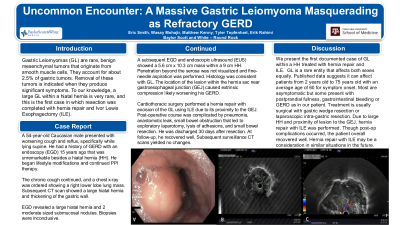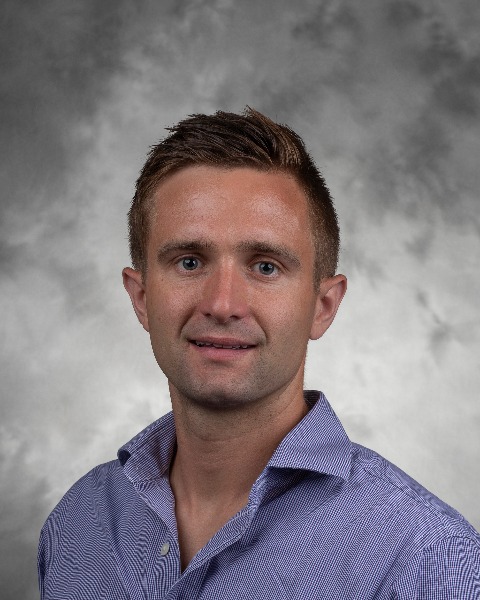Sunday Poster Session
Category: Stomach
P1647 - Uncommon Encounter: A Massive Gastric Leiomyoma Masquerading as Refractory GERD
Sunday, October 27, 2024
3:30 PM - 7:00 PM ET
Location: Exhibit Hall E

Has Audio

Eric Smith, MD
Baylor Scott & White Medical Center
Round Rock, TX
Presenting Author(s)
Award: Presidential Poster Award
Eric Smith, MD1, Wasay A. Mohajir, DO1, Matthew Kenny, BS1, Tyler Tepfenhart, DO2, Erik Rahimi, MD1
1Baylor Scott & White Medical Center, Round Rock, TX; 2Baylor Scott & White Medical Center, Georgetown, TX
Introduction: Gastric Leiomyomas (GL) are rare, benign mesenchymal tumors that originate from smooth muscle cells. They account for about 2.5% of gastric tumors. Removal of these tumors is indicated when they produce significant symptoms. To our knowledge, a large GL within a hiatal hernia is very rare, and this is the first case in which resection was completed with hernia repair and Ivor Lewis Esophagectomy (ILE).
Case Description/Methods: A 54-year-old Caucasian male presented with worsening cough and reflux, specifically while lying supine. He had a history of GERD with an endoscopy (EGD) 15 years ago that was unremarkable besides a hiatal hernia (HH). He began lifestyle modifications and continued PPI therapy.
The chronic cough continued, and a chest x-ray was ordered showing a right lower lobe lung mass. Subsequent CT scan showed a large hiatal hernia and thickening of the gastric wall. EGD revealed a large hiatal hernia and 2 moderate sized submucosal nodules. Biopsies were inconclusive. A subsequent EGD and endoscopic ultrasound (EUS) showed a 5.6 cm x 10.3 cm mass within a 9 cm HH. Penetration beyond the serosa was not visualized and fine-needle aspiration was performed. Histology was consistent with GL. The location of the lesion within the hernia sac near gastroesophageal junction (GEJ) caused extrinsic compression likely worsening his GERD.
Cardiothoracic surgery performed a hernia repair with excision of the GL using ILE due to its proximity to the GEJ. Post-operative course was complicated by pneumonia, anastomotic leak, small bowel obstruction that led to exploratory laparotomy, lysis of adhesions, and small bowel resection. He was discharged 30 days after resection. At follow-up, he made a full recovery. Subsequent surveillance CT scans yielded no changes.
Discussion: We present the first documented case of GL within a HH treated with hernia repair and ILE. GL is a rare entity that affects both sexes equally. Published data suggests it can affect patients from 2 years old to 75 years old with an average age of 60 for symptom onset. Most are asymptomatic but some present with postprandial fullness, gastrointestinal bleeding or GERD as in our patient. Treatment is usually surgical with gastric wedge resection or laparoscopic intra-gastric resection. Due to large HH and proximity of lesion to the GEJ, hernia repair with ILE was performed. Though post-op complications occurred, the patient overall recovered well. Hernia repair with ILE may be a consideration in similar situations in the future.

Disclosures:
Eric Smith, MD1, Wasay A. Mohajir, DO1, Matthew Kenny, BS1, Tyler Tepfenhart, DO2, Erik Rahimi, MD1. P1647 - Uncommon Encounter: A Massive Gastric Leiomyoma Masquerading as Refractory GERD, ACG 2024 Annual Scientific Meeting Abstracts. Philadelphia, PA: American College of Gastroenterology.
Eric Smith, MD1, Wasay A. Mohajir, DO1, Matthew Kenny, BS1, Tyler Tepfenhart, DO2, Erik Rahimi, MD1
1Baylor Scott & White Medical Center, Round Rock, TX; 2Baylor Scott & White Medical Center, Georgetown, TX
Introduction: Gastric Leiomyomas (GL) are rare, benign mesenchymal tumors that originate from smooth muscle cells. They account for about 2.5% of gastric tumors. Removal of these tumors is indicated when they produce significant symptoms. To our knowledge, a large GL within a hiatal hernia is very rare, and this is the first case in which resection was completed with hernia repair and Ivor Lewis Esophagectomy (ILE).
Case Description/Methods: A 54-year-old Caucasian male presented with worsening cough and reflux, specifically while lying supine. He had a history of GERD with an endoscopy (EGD) 15 years ago that was unremarkable besides a hiatal hernia (HH). He began lifestyle modifications and continued PPI therapy.
The chronic cough continued, and a chest x-ray was ordered showing a right lower lobe lung mass. Subsequent CT scan showed a large hiatal hernia and thickening of the gastric wall. EGD revealed a large hiatal hernia and 2 moderate sized submucosal nodules. Biopsies were inconclusive. A subsequent EGD and endoscopic ultrasound (EUS) showed a 5.6 cm x 10.3 cm mass within a 9 cm HH. Penetration beyond the serosa was not visualized and fine-needle aspiration was performed. Histology was consistent with GL. The location of the lesion within the hernia sac near gastroesophageal junction (GEJ) caused extrinsic compression likely worsening his GERD.
Cardiothoracic surgery performed a hernia repair with excision of the GL using ILE due to its proximity to the GEJ. Post-operative course was complicated by pneumonia, anastomotic leak, small bowel obstruction that led to exploratory laparotomy, lysis of adhesions, and small bowel resection. He was discharged 30 days after resection. At follow-up, he made a full recovery. Subsequent surveillance CT scans yielded no changes.
Discussion: We present the first documented case of GL within a HH treated with hernia repair and ILE. GL is a rare entity that affects both sexes equally. Published data suggests it can affect patients from 2 years old to 75 years old with an average age of 60 for symptom onset. Most are asymptomatic but some present with postprandial fullness, gastrointestinal bleeding or GERD as in our patient. Treatment is usually surgical with gastric wedge resection or laparoscopic intra-gastric resection. Due to large HH and proximity of lesion to the GEJ, hernia repair with ILE was performed. Though post-op complications occurred, the patient overall recovered well. Hernia repair with ILE may be a consideration in similar situations in the future.

Figure: Gastric Leiomyoma within Hiatal Hernia Sac
Disclosures:
Eric Smith indicated no relevant financial relationships.
Wasay Mohajir indicated no relevant financial relationships.
Matthew Kenny indicated no relevant financial relationships.
Tyler Tepfenhart indicated no relevant financial relationships.
Erik Rahimi indicated no relevant financial relationships.
Eric Smith, MD1, Wasay A. Mohajir, DO1, Matthew Kenny, BS1, Tyler Tepfenhart, DO2, Erik Rahimi, MD1. P1647 - Uncommon Encounter: A Massive Gastric Leiomyoma Masquerading as Refractory GERD, ACG 2024 Annual Scientific Meeting Abstracts. Philadelphia, PA: American College of Gastroenterology.

